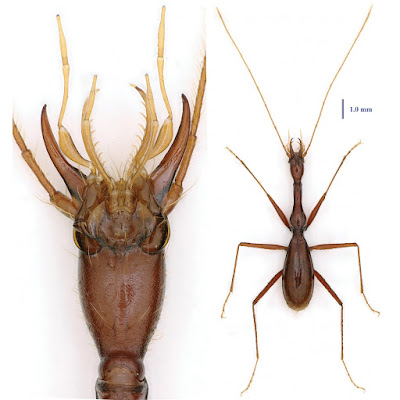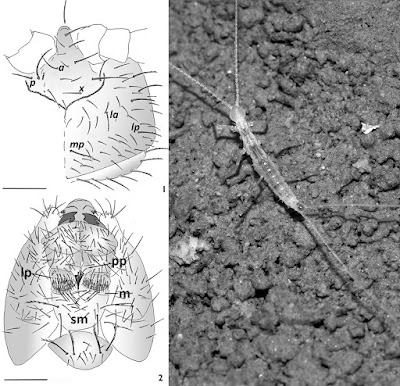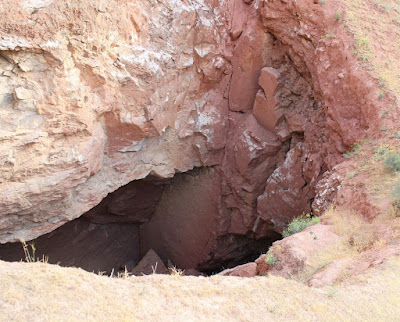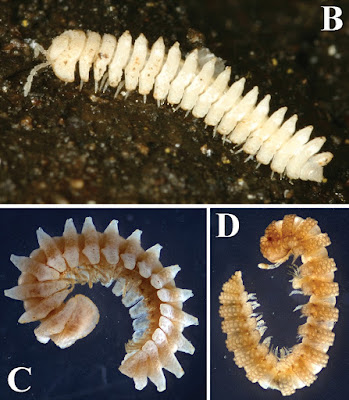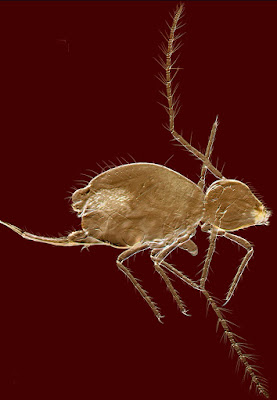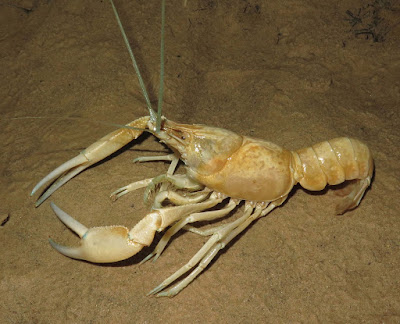| Aspidoras mephisto |
Abstract
Aspidoras mephisto n. sp. is described from the Anésio-Russão cave system, upper Tocantins River basin, Goiás, Brazil. The species can be readily distinguished from its congeners by troglomorphic features and also by presenting the following combination of features: infraorbital 1 generally with well-developed ventral laminar; or moderately developed; poorly-developed serrations on posterior margin of pectoral spine; nuchal plate not externally visible; dorsal fin, even in conspicuously colored specimens, with only dark brown or black chromatophores concentrated on rays, forming spots in some specimens; membranes hyaline; or sparse dark brown or black chromatophores on membranes, not forming any conspicuous pattern; and inner laminar expansion of infraorbital 1 moderately developed. Information about its habitat, ecology, behaviour and conservation status are provided and also a brief description of the juvenile stage.
Aspidoras mephisto, new species
| Fig 3. Aspidoras mephisto, holotype, MNRJ 48268, 45.6 mm SL, in dorsal (a), lateral (b) and ventral (c) views. |
| Fig 9. Live uncatalogued specimen of Aspidoras mephisto from the Anésio III cave, Posse, Goiás, Brazil. |
| Fig 12. Foraging habitat observed for Aspidoras mephisto. (a), touching the bottom parallel to; (b), touching the silty-bottom + roots showing a 60° angle to; (c), starting to foraging under the small roots; and (d), foraging behavior under the roots (arrow). |
| Fig 11. Map of the type-locality of Aspidoras mephisto, showing the Anésio-Russão cave-system, Posse, Goiás Brazil. Author: Diego M. von Schimonsky. |
| Fig 2. Habitat of Aspidoras mephisto at Anésio III cave, Posse Goiás, Brazil, showing (a), a small stretch of the drainage showing the roots reaching the water, lentic and formed by small roots and silt; (b), a pool with rocky in the border and silty-bottom, the black arrow indicates an adult specimen . (Photographs: Maria E. Bichuette). DOI: 10.1371/journal.pone.0171309 |
Geographical distribution: The new species is known only from the Anésio-Russão cave system (Anésio III and Russão II caves), part of the upper rio Tocantins basin (Fig 11).
Etymology: The epithet “mephisto” refers to the shortened name of Mephistopheles, demon from the German folklore. Mephistopheles comes from the Greek by the combination of three words: με (me), a negation, φῶς (phōs), meaning light, and φιλις (philis), meaning loving, literally “not-light-loving”, or the one who does not love the light, making allusion to the subterranean behavior of the new species. A noun in apposition.
Habitat, ecological and behavioral notes: Aspidoras mephisto shows preference to slow waters (small values of dissolved oxygen), small depths (ca. 0.05 m) and bottom formed by silt, clay and boulders, showing higher values of Total Dissolved Solutes compared to the epigean drainage. Its abundance is relatively high compared to other troglobitic fishes (ca. 50 individuals in pools), and population densities of 5–6 inds.m-2. Juvenile individuals were observed along small stretches of the drainage, always in lentic and shallow places, isolated from the adults and frequently under roots (Fig 2C).
Aspidoras mephisto forages calmly close to small submersed roots and silty-bottom (Fig 12A and 12B). They use the anterior extremity of the snout exploring the substrate in a parallel position or forming an angle of ca. 60° in relation to the bottom (Fig 12B), sometimes under the small roots (Fig 12C and 12D). The fish showed this behavior throughout the entire observation time (ca. 20 min) and did not show escape and/or avoidance behavior due to lamp-light or other external disturbances (such as the presence of the observer).
Luiz Fernando Caserta Tencatt and Maria Elina Bichuette. 2017. Aspidoras mephisto, New Species: The First Troglobitic Callichthyidae (Teleostei: Siluriformes) from South America. PLoS ONE. 12(3): e0171309. DOI: 10.1371/journal.pone.0171309
---------------------------------------------------------------
روابط التحميل والمشاهدة، الروابط المباشرة للتحميل
او
شاهد هذا الفيديو القصير لطريقة التحميل البسيطة
كيف تحصل على مدونة جاهزة بآلاف المواضيع والمشاركات من هنا
شاهد قناة منتدى مدونات بلوجر جاهزة بألاف المواضيع والمشاركات على اليوتيوب لمزيد من الشرح من هنا
رابط مدونة منتدى مدونات بلوجر جاهزة بآلاف المواضيع والمشاركات في أي وقت حــــتى لو تم حذفها من هنا
شاهد صفحة منتدى مدونات بلوجر جاهزة بألاف المواضيع والمشاركات على الفيس بوك لمزيد من الشرح من هنا
شاهد صفحة منتدى مدونات بلوجر جاهزة بألاف المواضيع والمشاركات على الفيس بوك لمزيد من الشرح من هنا
تعرف على ترتيب مواضيع منتدى مدونات بلوجر جاهزة بآلاف المواضيع والمشاركات (حتى لا تختلط عليك الامور) من هنا
ملاحظة هامة: كل عمليات تنزيل، رفع، وتعديل المواضيع الجاهزة تتم بطريقة آلية، ونعتذر عن اي موضوع مخالف او مخل بالحياء مرفوع بالمدونات الجاهزة بآلاف المواضيع والمشاركات، ولكم ان تقوموا بحذف هذه المواضيع والمشاركات والطريقة بسيطة وسهلة. ــــــــــــــــــــــــــــــــــــــــــــــــــــــــــــــــــــــــــــــسلامـ.




